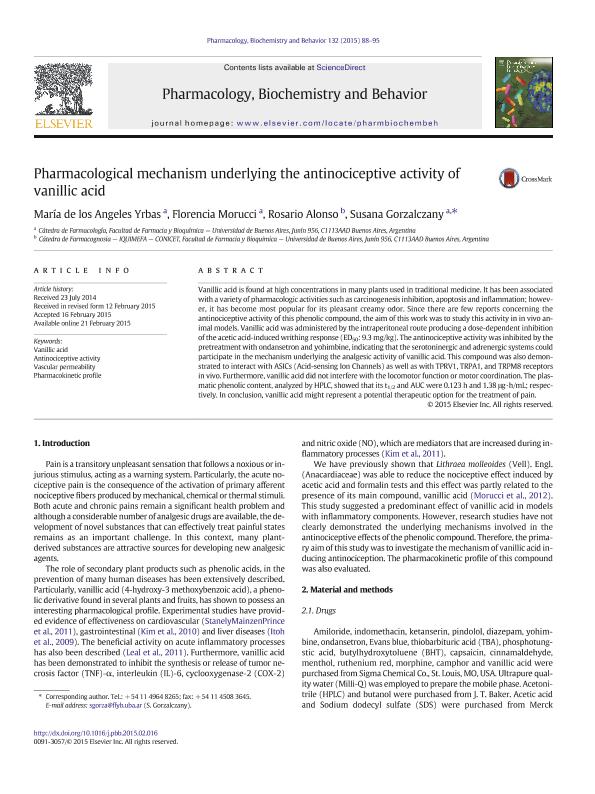Mostrar el registro sencillo del ítem
dc.contributor.author
Yrbas, Maria de Los Angeles

dc.contributor.author
Morucci, Florencia

dc.contributor.author
Alonso, Maria del Rosario

dc.contributor.author
Gorzalczany, Susana Beatriz

dc.date.available
2017-06-16T22:36:39Z
dc.date.issued
2015-05
dc.identifier.citation
Yrbas, Maria de Los Angeles; Morucci, Florencia; Alonso, Maria del Rosario; Gorzalczany, Susana Beatriz; Pharmacological mechanism underlying the antinociceptive activity of vanillic acid; Elsevier Inc; Pharmacology Biochemistry and Behavior; 132; 5-2015; 88-95
dc.identifier.issn
0091-3057
dc.identifier.uri
http://hdl.handle.net/11336/18397
dc.description.abstract
Vanillic acid is found at high concentrations in many plants used in traditional medicine. It has been associated with a variety of pharmacologic activities such as carcinogenesis inhibition, apoptosis and inflammation; however, it has become most popular for its pleasant creamy odor. Since there are few reports concerning the antinociceptive activity of this phenolic compound, the aim of this work was to study this activity in in vivo animal models. Vanillic acid was administered by the intraperitoneal route producing a dose-dependent inhibition of the acetic acid-induced writhing response (ED50: 9.3 mg/kg). The antinociceptive activity was inhibited by the pretreatment with ondansetron and yohimbine, indicating that the serotoninergic and adrenergic systems could participate in the mechanism underlying the analgesic activity of vanillic acid. This compound was also demonstrated to interact with ASICs (Acid-sensing Ion Channels) as well as with TPRV1, TRPA1, and TRPM8 receptors in vivo. Furthermore, vanillic acid did not interfere with the locomotor function or motor coordination. The plasmatic phenolic content, analyzed by HPLC, showed that its t1/2 and AUC were 0.123 h and 1.38 μg·h/mL; respectively. In conclusion, vanillic acid might represent a potential therapeutic option for the treatment of pain.
dc.format
application/pdf
dc.language.iso
eng
dc.publisher
Elsevier Inc

dc.rights
info:eu-repo/semantics/openAccess
dc.rights.uri
https://creativecommons.org/licenses/by-nc-sa/2.5/ar/
dc.subject
Vanillic Acid
dc.subject
Antinociceptive Activity
dc.subject
Vascular Permeability
dc.subject
Pharmacokinetic Profile
dc.subject.classification
Farmacología y Farmacia

dc.subject.classification
Medicina Básica

dc.subject.classification
CIENCIAS MÉDICAS Y DE LA SALUD

dc.title
Pharmacological mechanism underlying the antinociceptive activity of vanillic acid
dc.type
info:eu-repo/semantics/article
dc.type
info:ar-repo/semantics/artículo
dc.type
info:eu-repo/semantics/publishedVersion
dc.date.updated
2017-06-16T21:31:38Z
dc.journal.volume
132
dc.journal.pagination
88-95
dc.journal.pais
Estados Unidos

dc.description.fil
Fil: Yrbas, Maria de Los Angeles. Universidad de Buenos Aires. Facultad de Farmacia y Bioquímica. Departamento de Farmacología. Cátedra de Farmacología; Argentina. Consejo Nacional de Investigaciones Científicas y Técnicas; Argentina
dc.description.fil
Fil: Morucci, Florencia. Universidad de Buenos Aires. Facultad de Farmacia y Bioquímica. Departamento de Farmacología. Cátedra de Farmacología; Argentina
dc.description.fil
Fil: Alonso, Maria del Rosario. Universidad de Buenos Aires. Facultad de Farmacia y Bioquímica. Departamento de Farmacología. Cátedra de Farmacología; Argentina. Consejo Nacional de Investigaciones Científicas y Técnicas. Oficina de Coordinación Administrativa Houssay. Instituto de Química y Metabolismo del Fármaco. Universidad de Buenos Aires. Facultad de Farmacia y Bioquímica. Instituto de Química y Metabolismo del Fármaco; Argentina
dc.description.fil
Fil: Gorzalczany, Susana Beatriz. Universidad de Buenos Aires. Facultad de Farmacia y Bioquímica. Departamento de Farmacología. Cátedra de Farmacología; Argentina. Consejo Nacional de Investigaciones Científicas y Técnicas; Argentina
dc.journal.title
Pharmacology Biochemistry and Behavior

dc.relation.alternativeid
info:eu-repo/semantics/altIdentifier/url/http://www.sciencedirect.com/science/article/pii/S009130571500057X
dc.relation.alternativeid
info:eu-repo/semantics/altIdentifier/doi/http://dx.doi.org/10.1016/j.pbb.2015.02.016
Archivos asociados
